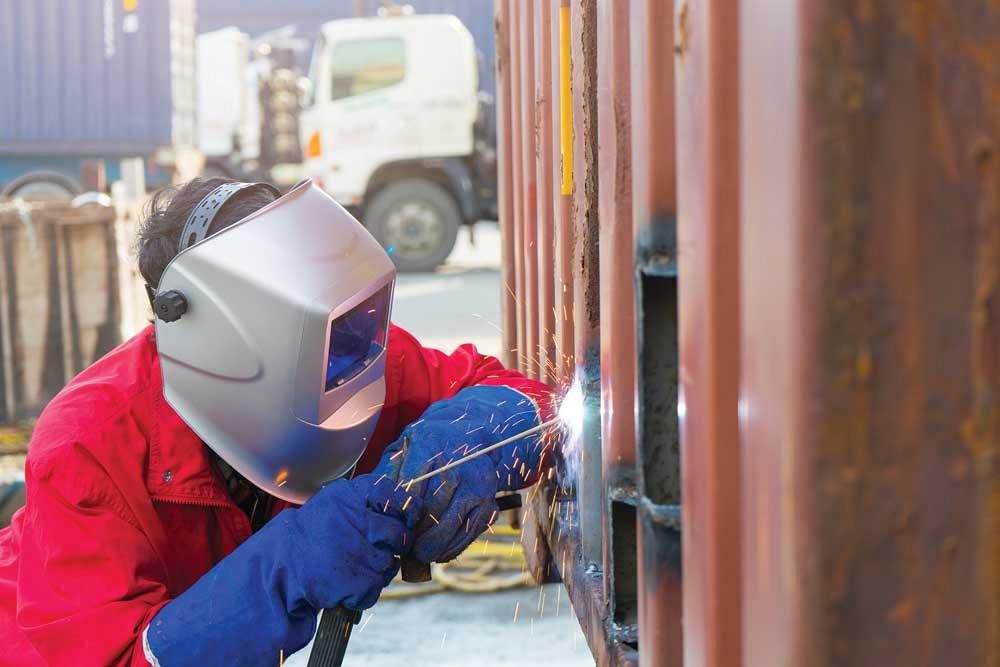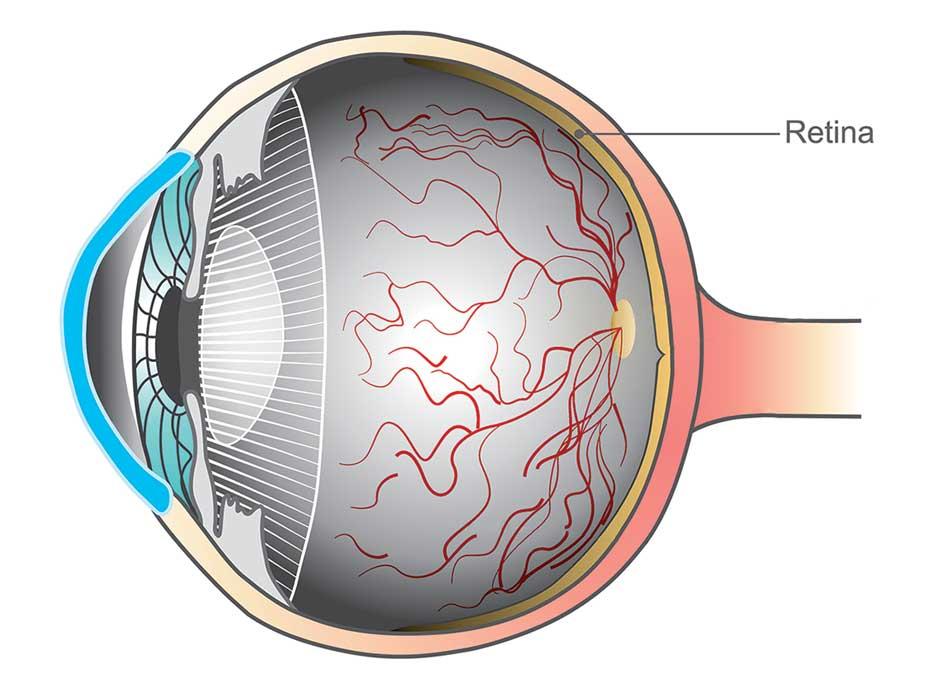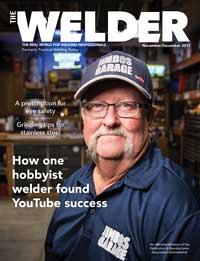Freelance writer
- FMA
- The Fabricator
- FABTECH
- Canadian Metalworking
Categories
- Additive Manufacturing
- Aluminum Welding
- Arc Welding
- Assembly and Joining
- Automation and Robotics
- Bending and Forming
- Consumables
- Cutting and Weld Prep
- Electric Vehicles
- En Español
- Finishing
- Hydroforming
- Laser Cutting
- Laser Welding
- Machining
- Manufacturing Software
- Materials Handling
- Metals/Materials
- Oxyfuel Cutting
- Plasma Cutting
- Power Tools
- Punching and Other Holemaking
- Roll Forming
- Safety
- Sawing
- Shearing
- Shop Management
- Testing and Measuring
- Tube and Pipe Fabrication
- Tube and Pipe Production
- Waterjet Cutting
Industry Directory
Webcasts
Podcasts
FAB 40
Advertise
Subscribe
Account Login
Search
Be wise and protect your eyes
Preventing the most common welding-related injury
- By Craig Guillot
- November 11, 2017
- Article
- Safety

Figure 1
Autodarkening welding helmets have proven to be one of the most important technology advancements as it relates to keeping welders’ eyes safe. The lens is automatically darkened to the shade necessary to protect the eyes when the arc is struck, allowing the welder to focus on the weld, not flipping the hood down.
Most welders are already well aware of the dangers they can face on the job. Heat, sparks, flying particles, noxious gases, and moving metal can all present a risk of injury. As one of the most important and sensitive organs in the human body, the eyes are especially susceptible to injury. And although eye-related injuries represent one of the most common accidents on the job, experts say they are also the most easily prevented.
Having knowledge of the risks and using the proper personal protective equipment can go a long way in preventing injury.
Seeing the Dangers
According to the Bureau of Labor Statistics, more than 20,000 workplace eye injuries occur each year, costing hundreds of millions of dollars in lost productivity, medical treatment, and workers’ compensation. Welders have a total incidence injury rate of 163 per 10,000 workers and a high rate of injuries caused by heat and exposure to harmful substances. A study by Liberty Mutual Research Institute for Safety found that roughly one-quarter of all welding injuries involve the eyes.
Gases, flying particles, heat, and light can all present a hazard to unprotected eyes, and even the most experienced and safety-conscious welders can sustain a minor injury during the course of their career.
“Eye injuries are the most common types of injuries for welders,” said Charles Flowers, MD, associate professor of clinical ophthalmology at the USC Roski Eye Institute in Los Angeles. “There are a lot of things that can happen, but the main risks are from flying particles, chemical burns, and radiation.”
Nearly all types of welding, including gas metal arc welding (GMAW), oxyacetylene welding (OAW), and shielded metal arc welding (SMAW), can also present risk of injury to the eyes. Steve Hedrick, manager of safety and health at the American Welding Society, said nearly 70 percent of eye-related injuries in welders are caused by falling objects, flying particles, or sparks hitting the eye. While these injuries can at times be serious, they are also the most preventable by using proper personal protective equipment (PPE).
Most welders are cognizant of the PPE they’re supposed to use, but discomfort and heat often can entice some to skimp on safety. Derek Baker, senior technical service specialist at 3M, said one of the most common paths to injury is when welders don’t wear goggles under their mask. They flip up their mask to make what they figure is a quick, low-risk adjustment or grind and leave their eyes exposed.
“Cheating, or not having the proper PPE on hand and just doing the work, is a quick way to injury. You’ve got to have the safety spectacles on all the time as your primary protection wear under your helmet,” Baker explained.
Manufacturers are now making these products more comfortable and performance-driven. Proper fit and comfort is critical for goggles and masks. While a hardhat and welding helmet might meet the minimum PPE standards required by OSHA, some new systems incorporate head, eye, face, respiratory, and hearing protection all in one unit. Some of these units even have cooling fans to keep the face cool and reduce fogging.
“[These designs] allow you to do both welding and grinding with one unit, and you’ve always got the proper PPE at hand. You never have to swap out your welding helmet and grinding shield,” Baker said.

Figure 2
The risk to the retina may be minimal when it comes to injuries such as “eye arc,” but the damage, should an injury to the retina occur, could be great. The retina is a thin layer of tissue that lines the back of the eye on the inside. The purpose of the retina is to receive light that the lens has focused, convert the light into neural signals, and send these signals on to the brain for visual recognition. Damage to the retina can greatly decrease a person’s ability to see clearly.
Corneal Flash Burn
Another risk welders face is corneal flash burns from UV light and radiation produced by the arc. Also known as “arc eye,” photokeratitis, or ultraviolet keratitis, can occur when the welder looks directly at the arc without proper protection. The condition typically isn’t permanent, but it can be painful and involve swelling and tearing of the cornea. Yet because UV rays are invisible to the naked eye, the problems related to exposure often go undetected until symptoms arise. These symptoms can include bloodshot eyes, light sensitivity, blurry vision, tearing, and even the sensation of an object inside the eye.
“It usually clears up in 48 hours. While more severe cases are rare, they can cause [permanent] damage to the retina,” Flowers noted.
UV rays reflecting from surfaces can even put bystanders at risk and can cause damage to the eyes from as far as 50 feet away. The best way to reduce the risk of corneal flash burn is to ensure the goggles or mask is equipped with the appropriate shade filter. Many masks now have autodarkening filters that ensure the welder is using the right shade and eliminate the need to constantly raise and lower the helmet. Autodarkening filters also often include a special filter that can block harmful radiation even if the main element fails.
“A lot of welders are using autodarkening lenses now, and it completely eliminates the need to continuously flip the helmet,” Hedrick said.
Baker said new antifog coatings also reduce the urge for the welder to continually remove the mask and goggles from the head. Top-quality helmets fit various head sizes, offer multiple adjustment combinations, and avoid putting pressures on sensitive areas. A good helmet also has a lightweight design that allows it to be worn more comfortably for long periods of time. The helmet should include a fore and aft adjustment to offer enough space between the helmet and the face to allow for good airflow. Many helmets also offer controls that allow the welder to adjust the shade based on light sensitivities and personal preferences.
Hedrick said for all types of electric arc processes, welding helmets should comply with ANSI Z87.1 and be equipped with the correct filter shade that aligns with the welding process being performed and the arc current being used. Shades range from a minimum protection of 4 for plasma arc cutting to 11 for SMAW at 250 amps. For clarity on PPE, welders can refer to the “OSHA Eye and Face Protector Selection Guide” and the “Eyewear Applications Guide.”
Continuous Commitment to Eye Safety
Welders need to ensure they’re not only using the right protective gear, but that it is well-maintained and functions properly. Rachel Bishop, MD, MPH, chief of the Consult Services Section at the National Eye Institute, explained that welders should regularly inspect their protective masks and eyewear and replace parts as needed. Even small scratches in the lens could allow the welder’s eyes to be exposed to UV rays. “The equipment works in blocking UV light but only if it is not scratched or damaged, so the lens needs to be regularly inspected,” Bishop said.
It’s important for nonwelders to be protected too when in the presence of welding. This may call for protective screens, curtains, or even fume hoods to displace hazardous gases.
Welders and their employers need to engage in continuous eye safety training and awareness and understand basic emergency eye care. The American Academy of Ophthalmology (AAO) says that serious eye injuries are not always immediately obvious, and that delaying medical attention can cause the damaged areas to worsen and even result in permanent vision loss. AAO advises workers not to rub away particles or foreign matter from their eyes. Instead, they should lift the upper eyelid over the lashes of the lower lid or blink several times and allow the tears to flush out the particle.
Bishop said it’s important never to try to remove anything that punctures the eye no matter how painful. “You never want to pull anything out of your eyes because it may cause the wound to open and basically empty the eye contents. If you think something is stuck in your eye, don’t touch it and immediately see a doctor,” Bishop said.
About the Author
About the Publication
subscribe now

The Welder, formerly known as Practical Welding Today, is a showcase of the real people who make the products we use and work with every day. This magazine has served the welding community in North America well for more than 20 years.
start your free subscription- Stay connected from anywhere

Easily access valuable industry resources now with full access to the digital edition of The Fabricator.

Easily access valuable industry resources now with full access to the digital edition of The Welder.

Easily access valuable industry resources now with full access to the digital edition of The Tube and Pipe Journal.
- Podcasting
- Podcast:
- The Fabricator Podcast
- Published:
- 04/16/2024
- Running Time:
- 63:29
In this episode of The Fabricator Podcast, Caleb Chamberlain, co-founder and CEO of OSH Cut, discusses his company’s...
- Industry Events
16th Annual Safety Conference
- April 30 - May 1, 2024
- Elgin,
Pipe and Tube Conference
- May 21 - 22, 2024
- Omaha, NE
World-Class Roll Forming Workshop
- June 5 - 6, 2024
- Louisville, KY
Advanced Laser Application Workshop
- June 25 - 27, 2024
- Novi, MI































